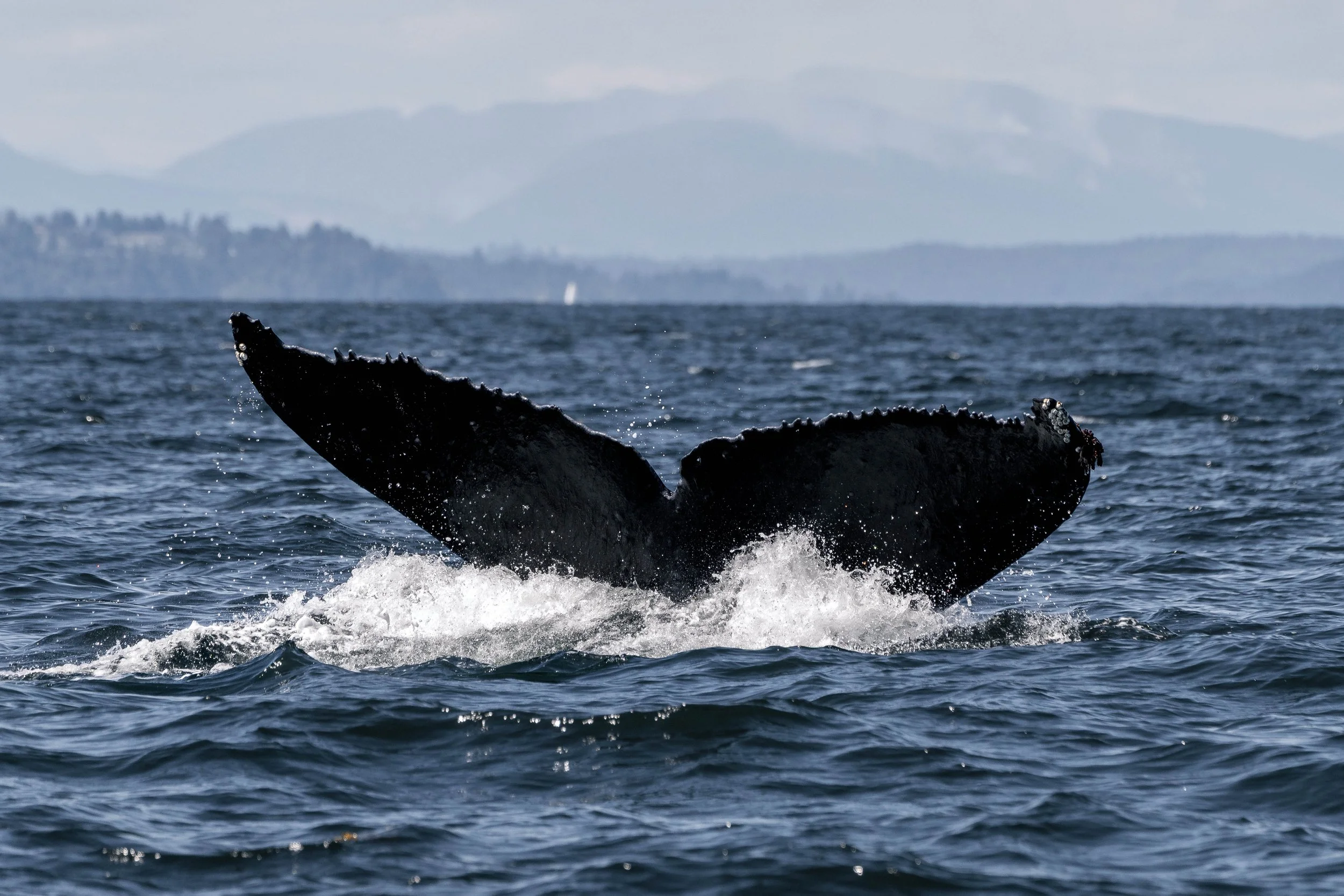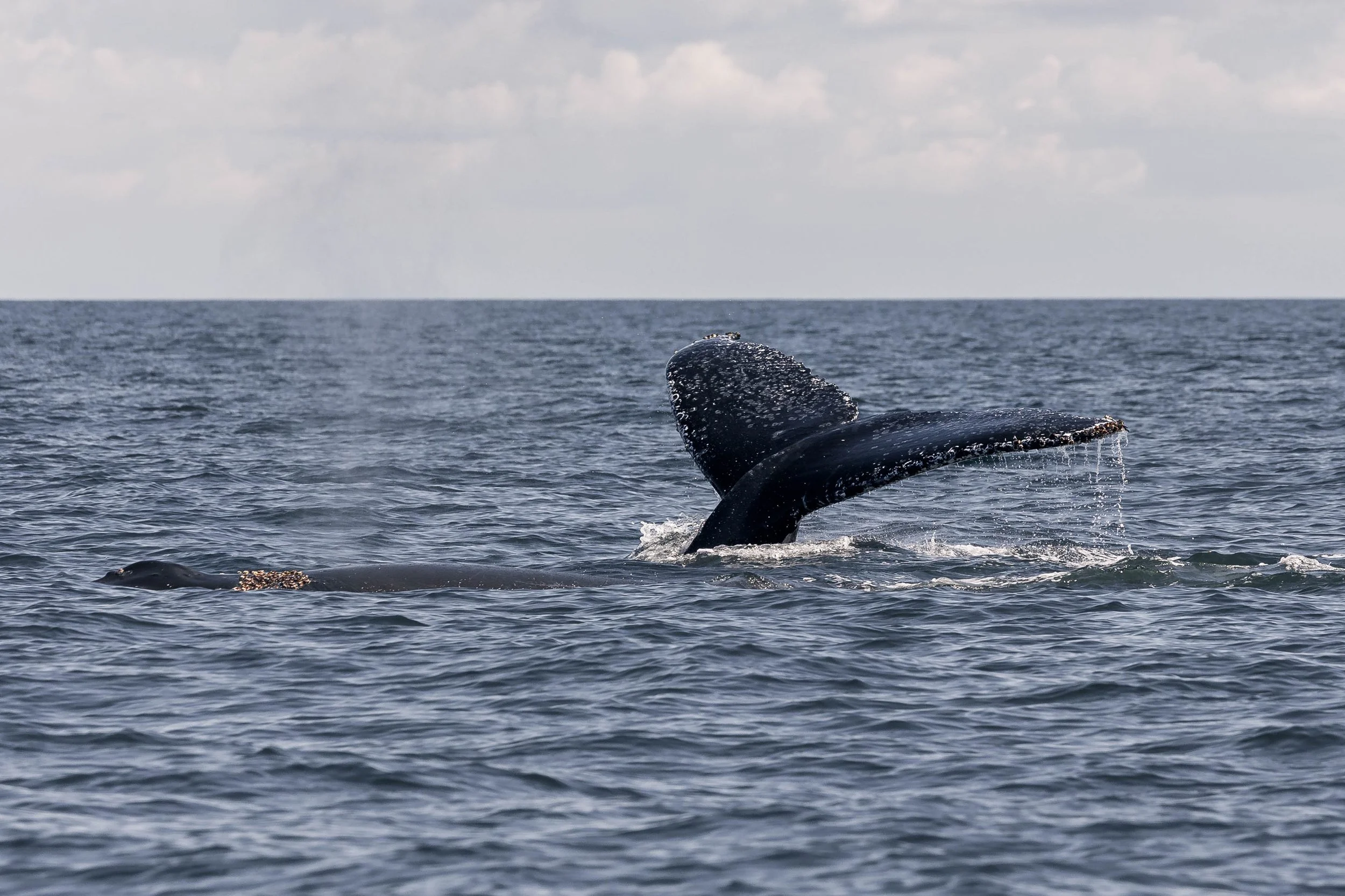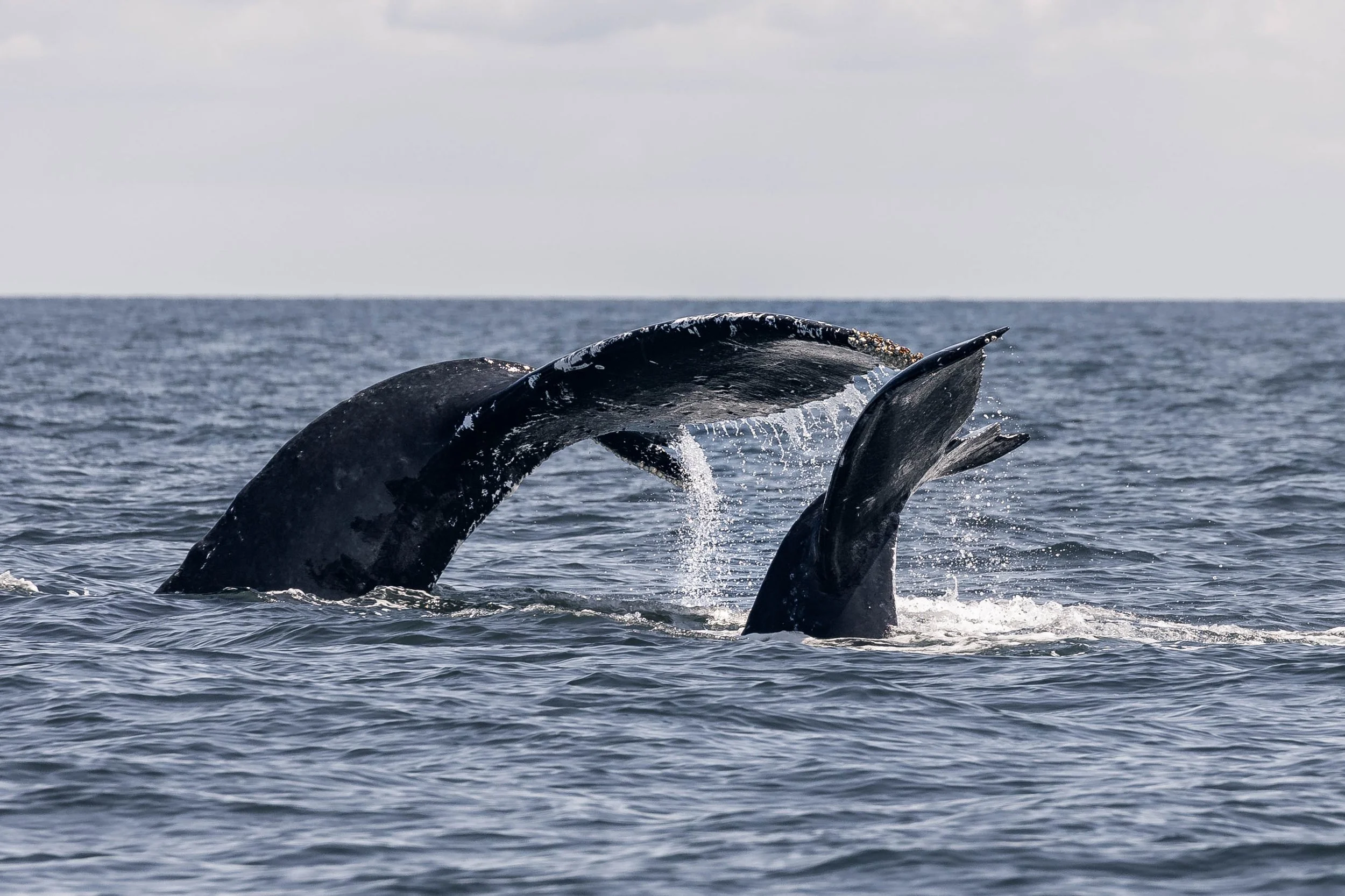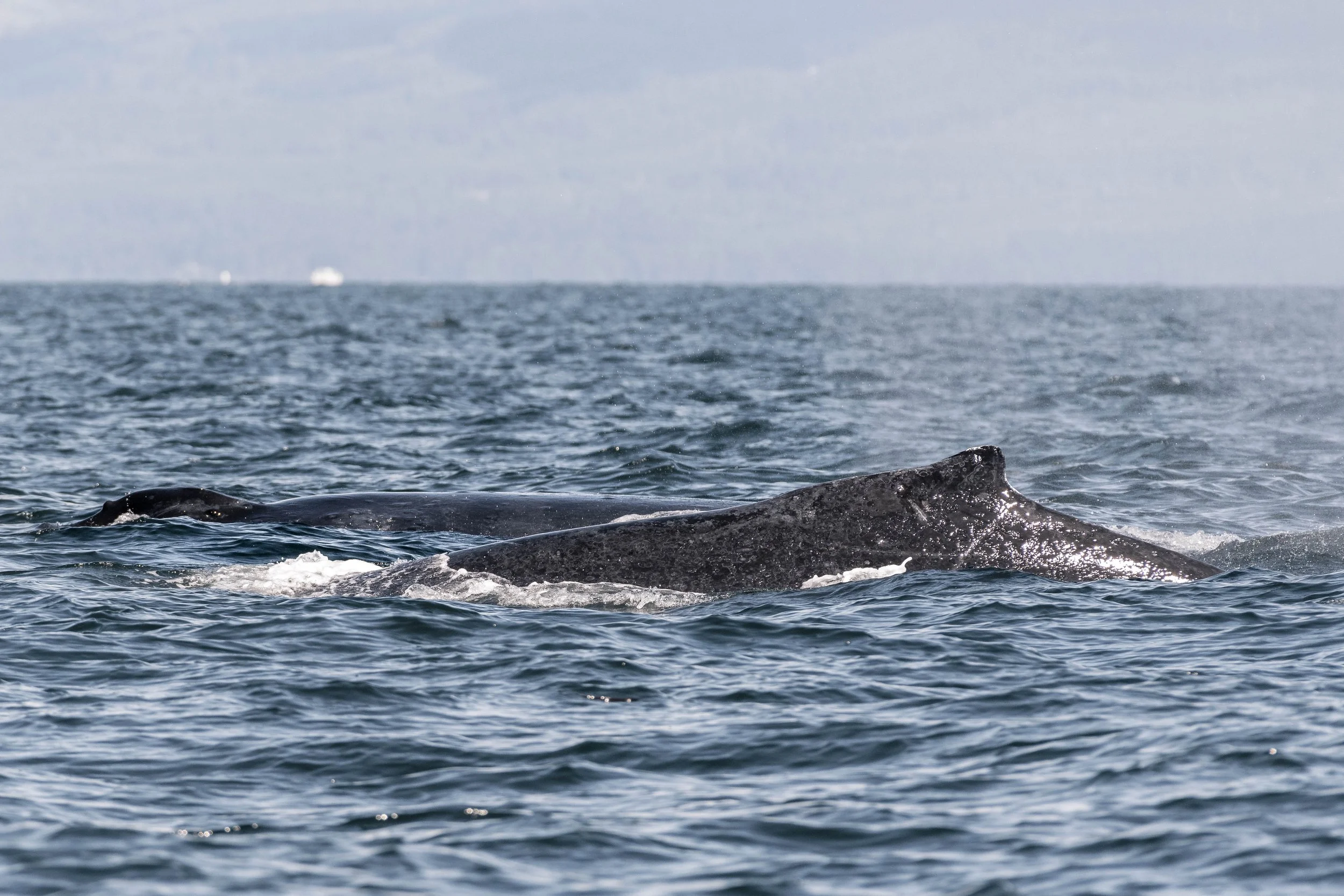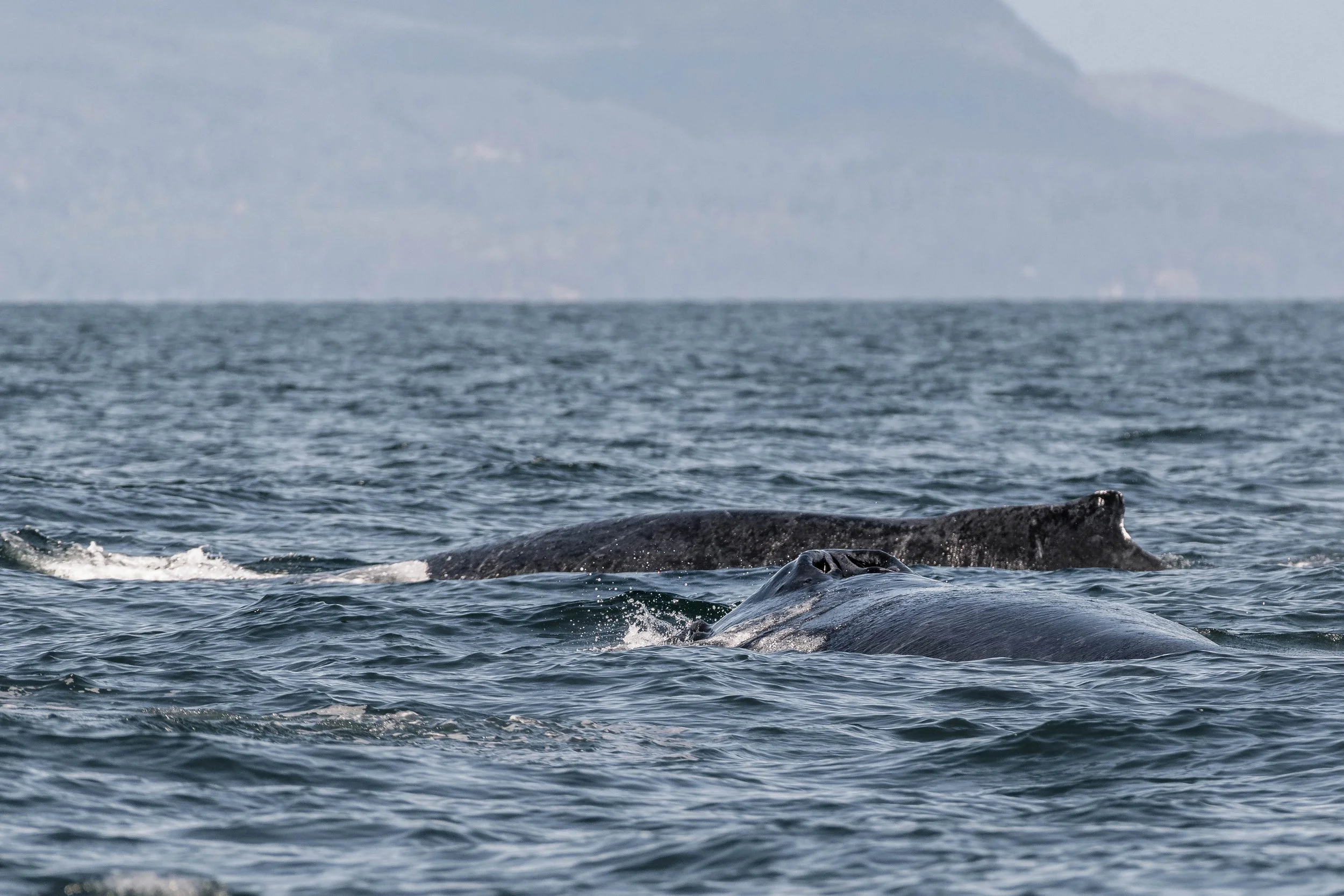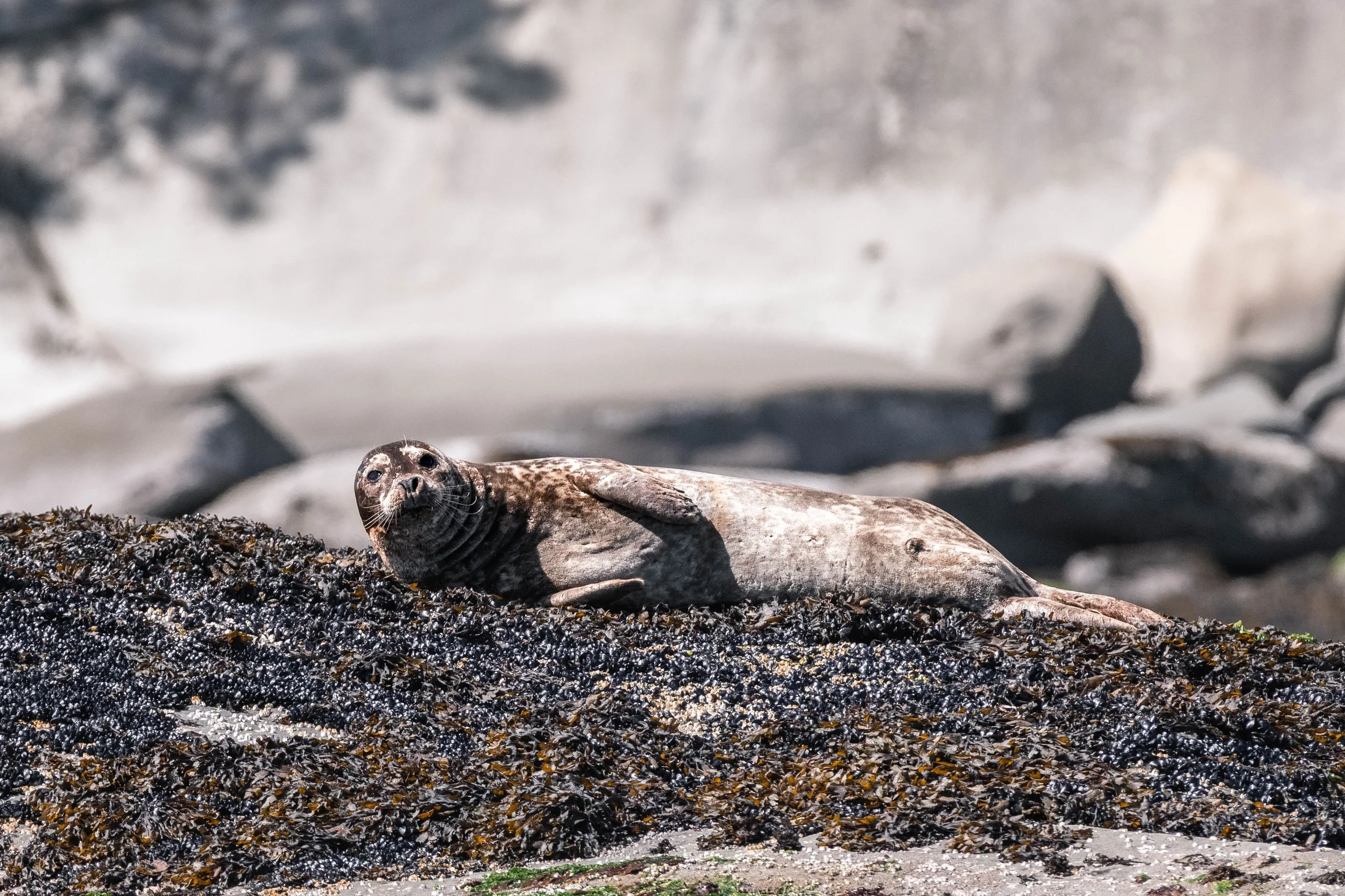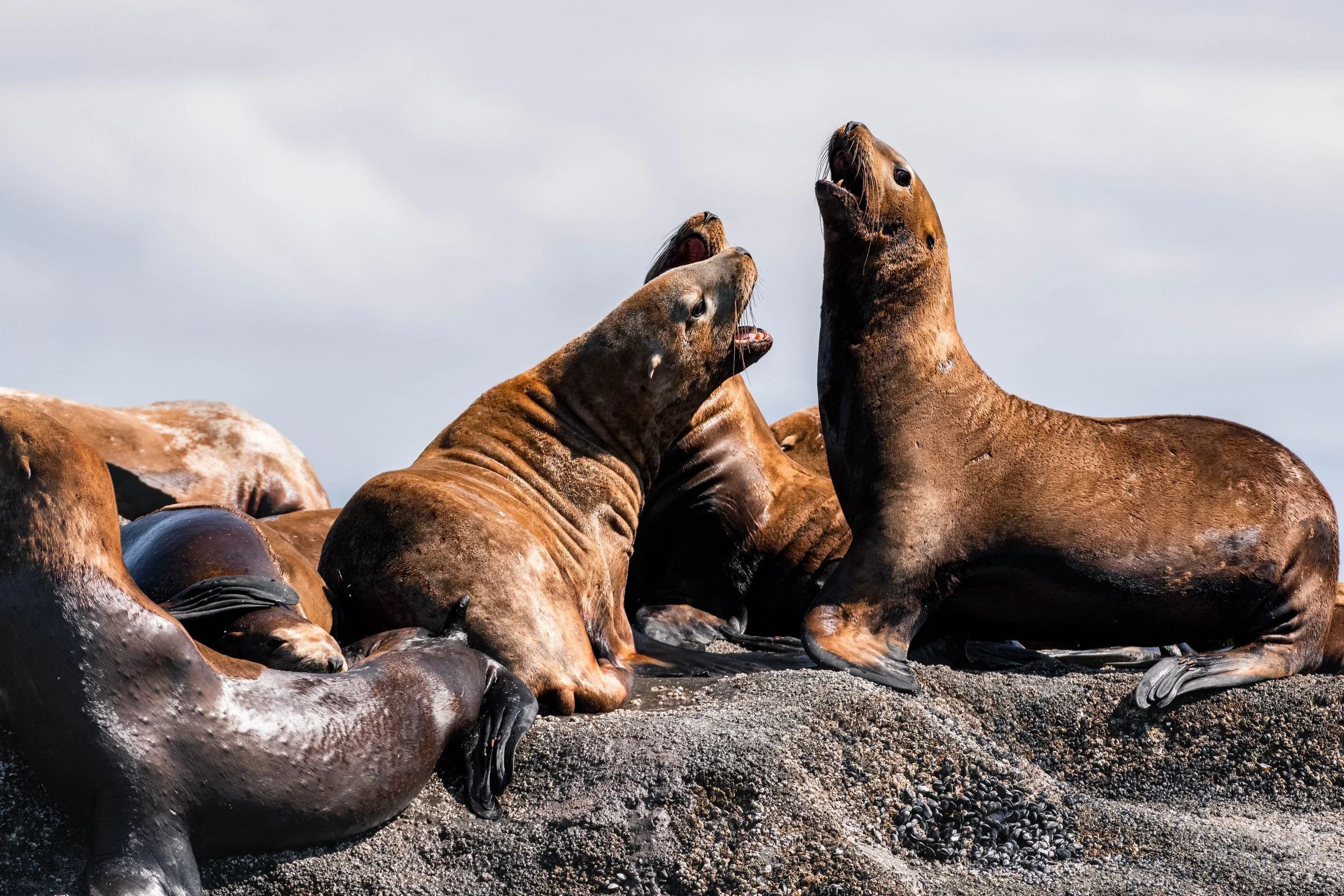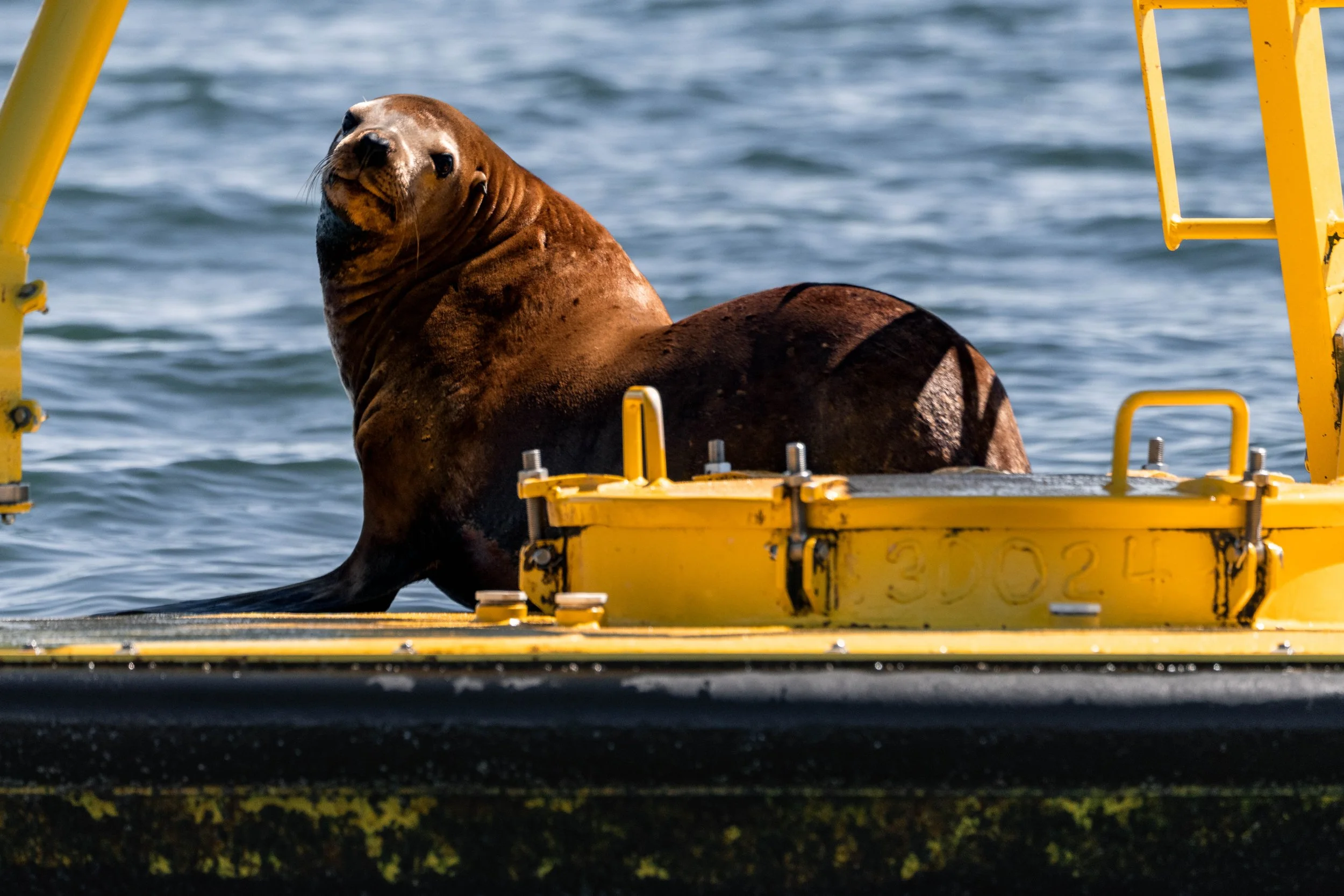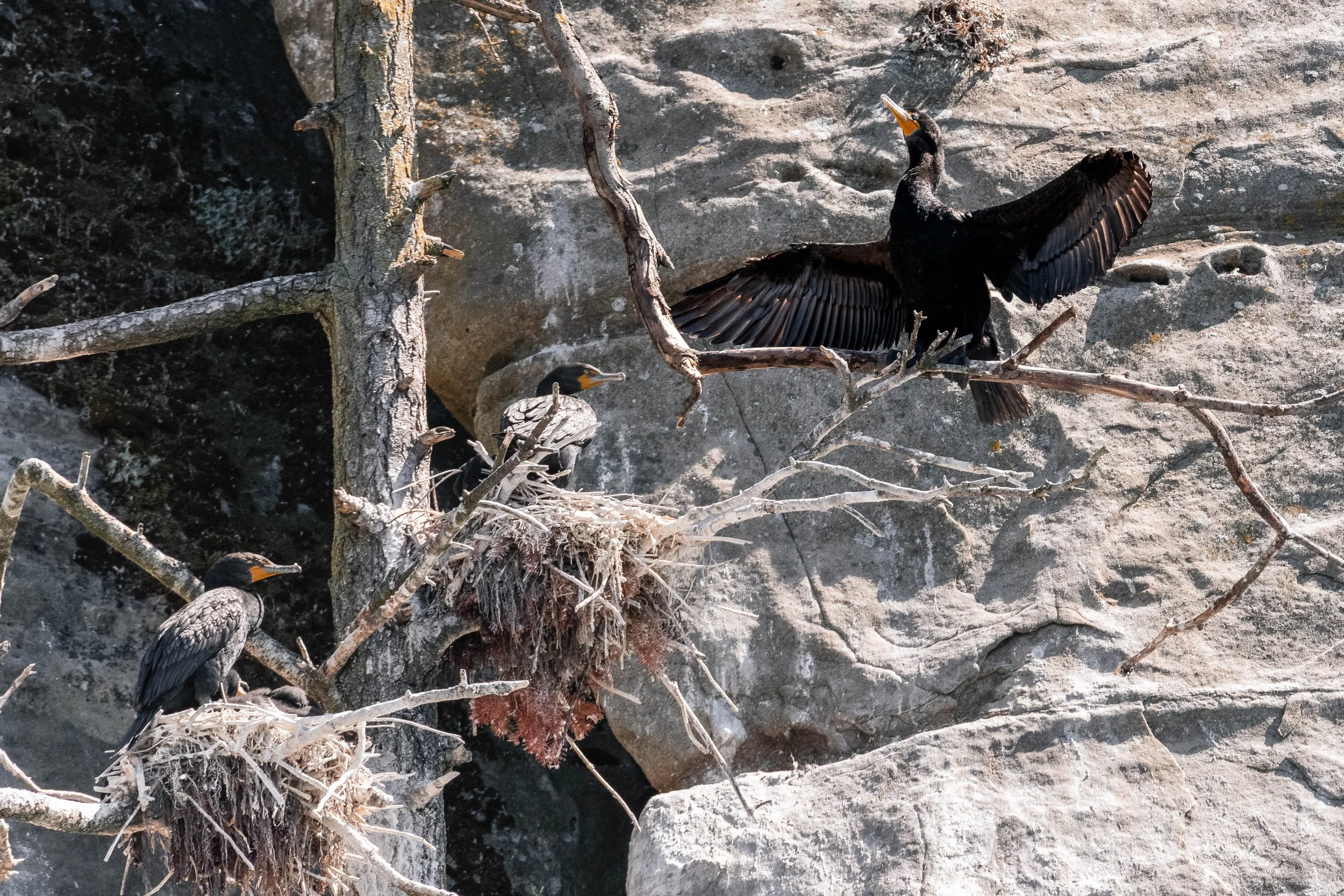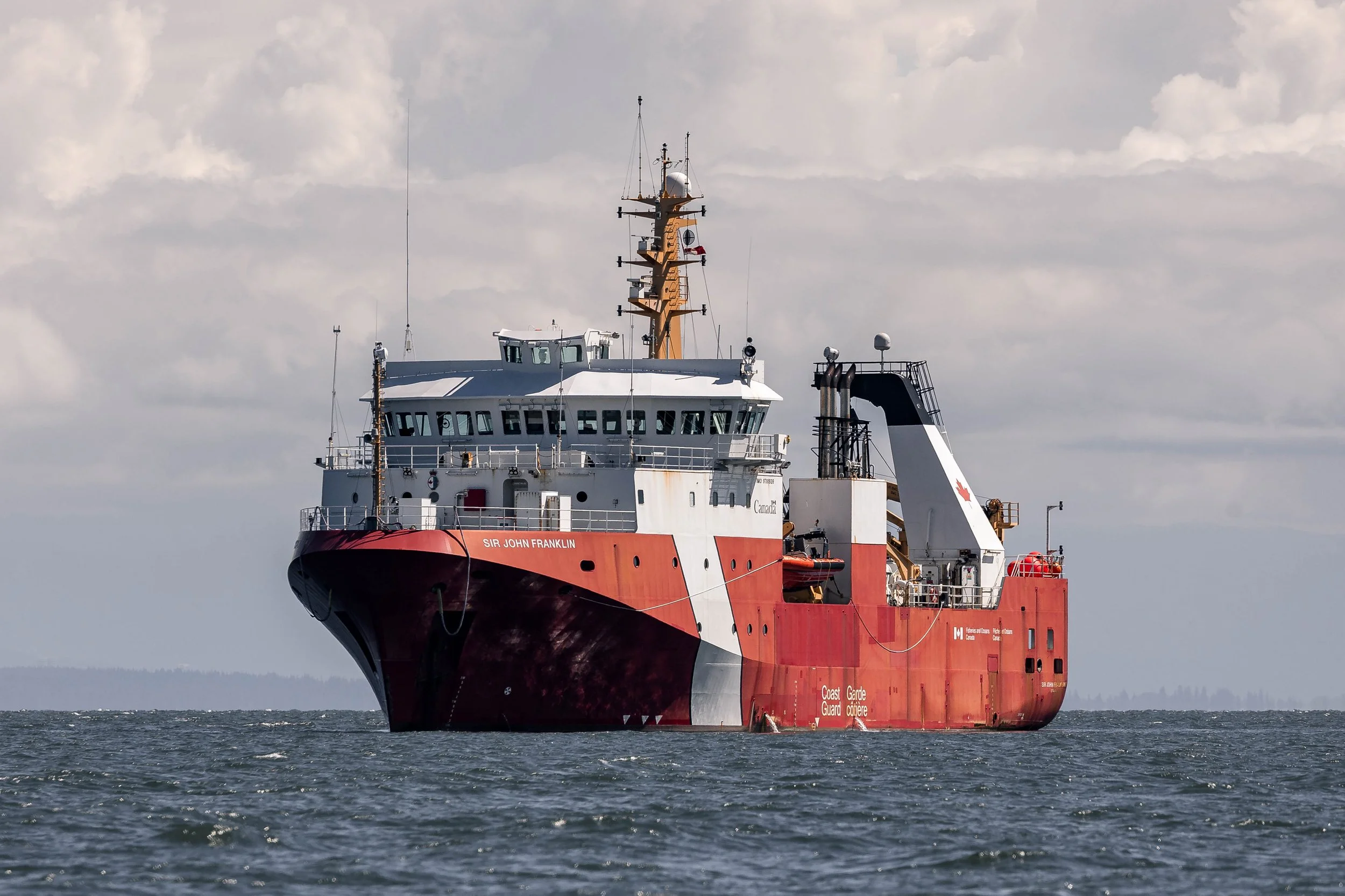August 7, 2025, 10:30 AM - Changing Associations with our Humpback Whales
The sun was shining as our fleet pushed off the dock, eager and excited to get out and begin exploring. The early portion of the trip was spent southbound, entering the Southern Gulf Islands and scanning inside the islands. Our fleet spread out, a technique used to spread our sightlines as far as possible, and to maximize our chances at locating whales. Today, our ventures in the islands were a bust, with no whales to be found, so the adventures continued outside into the Strait of Georgia. Our open boat, Cascadia, and semi-covered boat, Kula, headed over to Stinky Rocks, a popular haulout for the pinnipeds. Here, several Harbour Seals were perched high up on the rocks, posing and lounging in the sunshine. Our Steller Sea Lions, on the other hand, were being loud and proud as always, growling and snapping and fighting away amongst each other. Right now, we do not have any large Male Steller Sea Lions in our area, as most of them are busy up in the breeding grounds. Once the salmon runs begin, we will see a significant increase in sea lion numbers again!
After departing our pinnipeds, the journey continued, and we began searching the open waters of the Strait of Georgia. This vast expanse is home to many different species of animals, from tiny krill to the gentle humpback giants. We scanned and scanned, when suddenly, huge blows were spotted in the distance! We made our way over and began the exciting adventure of identifying our whales. When we first spotted them, there were two pairs of whales travelling individually, for a total of 4 whales. Shortly after we arrived, the pairs met up, and the four whales began interacting and socializing together, diving and racing side-by-side. Our Naturalists started snapping photos, and from comparing dorsal fins and occasional flukes, we identified the initial pairs as Twinning (BCX1207) and Bond (BCX1640), and then Tempest (BCX0837) and Geometry (BCZ0338). When the pairs converged, they were spotted lunging along the surface, snapping their jaws shut and taking in huge gulps of food. After the explosive lunge feeding at the surface, they continued travelling along, occasionally fluking as they prepared to dive deeper into the waters below.
Besides feeding, the humpbacks were also spotted Pectoral Slapping, or Pec Slapping, on the surface. Pec slapping is a behaviour that scientists are still studying and learning about, as the reasons behind it are still not fully understood. Some proposed possibilities are that it could be a form of communication (something along the lines of “There’s lots of grub here! Come join us!” or as a warning, such as “There’s danger over here! Stay away!”), a way to clear parasites off their skin (when their pecs break the surface of the water and then slap back on it, the sheer force can cause barancles or other tagalongs to be pulled clear of the skin), or potentially just a form of play! Much of our knowledge regarding humpbacks is very new, with most of it being discovered in the past 30 years. Give it another 30 years, and there is potential for a lot of currently believed knowledge to turn out to be inaccurate as we study and learn about them more!
Soon after, our boats departed and began searching once more. Our open vessel Keta made their way over to the Halibut Bank ODAS buoy to look for pinnipeds, as they had not visited Stinky Rocks earlier in the day. Buoys are a great spot for our pinnpeds to rest on, as these floating markers always stay at the surface of the water, no matter the tide conditions. This means that the seals and sea lions on them always have a place to snooze on, versus the pinnipeds that choose Stinky Rocks, which may need to move to a different haulout during high tides, where the waters can submerge the rocks.
While Keta was peeking at sea lions, our semi-covered vessel Kula located another trio of humpbacks to the south, close to Gabriola Island. These three were also travelling and fluking, with one of them appearing significantly smaller than the other two. After grabbing some photos, our Naturalist identified the pair as Kappa (BCX0158) and Kappiroto (BCX0158 calf 2025), but the third one was a bit trickier as it kept diving at angles where we couldn’t spot the underside pattern. This whale was identified less traditionally - after grabbing some photos of their dorsal fluke (top side of their tail), and comparing to a couple of photos they had on hand, this whale was identified as Watson/Cerulean (BCY1461)!
Watson has a very spotty top fluke (check out the photos of it below!), which isn’t super common amongst our humpbacks. At four years old, there are two ways this could have happened: they may have had a skin condition when they were a newborn, or they could have had a heavy barnacle load leading to indentations all over it. These indents may lessen as they age, but for now, it’s a great way to help confirm who they are!
While these whales were mostly travelling and fluking, likely feasting away deeper in the water column, the excited calf had quite a bit of energy built up and ended up breaching once! Breaching is a massive calorie burner, and a rare behaviour to witness. The behaviour seems to be a bit more common amongst calves, who may have the energy to burn due to the highly nutritious milk they consume from their mothers.
To wrap up the day, we had one last wildlife stop over at the Gabriola Bluffs. Here, several Comorants were waddling along the cliffside, squawking away, and enjoying the sunshine. A few of them could also be seen with their wings outstretched, as if about to fly, but not flapping at all. This behaviour may seem odd for a creature such as a bird, but there is a very good reason for it! Cormorants are amazing fishing birds and can dive over a hundred feet down into the water to catch a meal for themselves and their chicks. This incredible underwater performance does come with one big and glaring fault, though - their feathers are not waterproof! If their feathers were waterproof, they would struggle to dive down. Because of this, Cormorants are required to dry their wings off before they can take to the sky and return to their nests - to do this, they stretch their wings out just like we saw today!
We left the Bluffs behind and headed back into the harbour, ending the day happily after encountering a huge variety of species all around the Salish Sea!
Please enjoy these photos by Marine Naturalists Val Watson, Cheyenne Brewster, and Aly Kohlman!
Geometry’s fluke. Photo by Val Watson.
Tempest’s dorsal fin. Photo by Val Watson.
Geometry pec slapping, with half of their fluke out of the water. Photo by Val Watson.
Twinning’s fluke. Photo by Val Watson.
Bond’s fluke. Photo by Cheyenne Brewster.
Twinning’s dorsal fin. Photo by Cheyenne Brewster.
Watson diving, with Kappiroto in front of them. Photo by Cheyenne Brewster.
Kappa (back) and Kappiroto (front) arching to dive. Photo by Cheyenne Brewster.
Mother Kappa and calf Kappiroto, fluking together. Photo by Cheyenne Brewster.
The group travelling together. Photo by Aly Kohlman.
Geometry’s fluke. Photo by Aly Kohlman.
Geometry’s dorsal fin with a friend behind them. Photo by Aly Kohlman.
Geometry’s dorsal fin (back) and the nostrils of a friend. Photo by Aly Kohlman.
A Harbour Seal waking up from a nap to peek at us. Photo by Aly Kohlman.
Getting the best spots on the rocks can be quite the fight! Photo by Aly Kohlman.
A sleepy Steller Sea Lion watches us from the ODAS buoy. Photo by Val Watson.
A Belted Kingfisher perching. Photo by Val Watson.
A Bald Eagle walking on the rocks. Photo by Aly Kohlman.
Cormorants sunning and sitting on nests. Photo by Aly Kohlman.
Coromorants on the rocks, with one sunning its wings. Photo by Aly Kohlman.
A Cormorant with nest material in its beak. Photo by Val Watson.
The Sir John Franklin, a DFO research vessel. Photo by Cheyenne Brewster.




